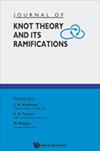纤维正链琼斯多项式的新条件
IF 0.4
4区 数学
Q4 MATHEMATICS
引用次数: 0
摘要
我们给出了纤维正链节的琼斯多项式最大度的新上限。特别是,我们证明了纤正结的琼斯多项式的最大度最多是最小度的四倍。利用这一结果,我们可以完成将交叉数≤12 的所有结划分为正结或非正结的工作,证明剩余的七个未知正结不是正结。大约在同一时间,斯托伊梅诺也独立完成了这一分类。本文章由计算机程序翻译,如有差异,请以英文原文为准。
A new condition on the Jones polynomial of a fibered positive link
We give a new upper bound on the maximum degree of the Jones polynomial of a fibered positive link. In particular, we prove that the maximum degree of the Jones polynomial of a fibered positive knot is at most four times the minimum degree. Using this result, we can complete the classification of all knots of crossing number as positive or not positive, by showing that the seven remaining knots for which positivity was unknown are not positive. That classification was also done independently at around the same time by Stoimenow.
求助全文
通过发布文献求助,成功后即可免费获取论文全文。
去求助
来源期刊
CiteScore
0.80
自引率
40.00%
发文量
127
审稿时长
4-8 weeks
期刊介绍:
This Journal is intended as a forum for new developments in knot theory, particularly developments that create connections between knot theory and other aspects of mathematics and natural science. Our stance is interdisciplinary due to the nature of the subject. Knot theory as a core mathematical discipline is subject to many forms of generalization (virtual knots and links, higher-dimensional knots, knots and links in other manifolds, non-spherical knots, recursive systems analogous to knotting). Knots live in a wider mathematical framework (classification of three and higher dimensional manifolds, statistical mechanics and quantum theory, quantum groups, combinatorics of Gauss codes, combinatorics, algorithms and computational complexity, category theory and categorification of topological and algebraic structures, algebraic topology, topological quantum field theories).
Papers that will be published include:
-new research in the theory of knots and links, and their applications;
-new research in related fields;
-tutorial and review papers.
With this Journal, we hope to serve well researchers in knot theory and related areas of topology, researchers using knot theory in their work, and scientists interested in becoming informed about current work in the theory of knots and its ramifications.

 求助内容:
求助内容: 应助结果提醒方式:
应助结果提醒方式:


